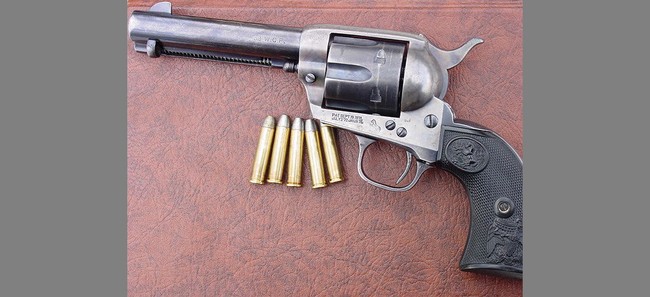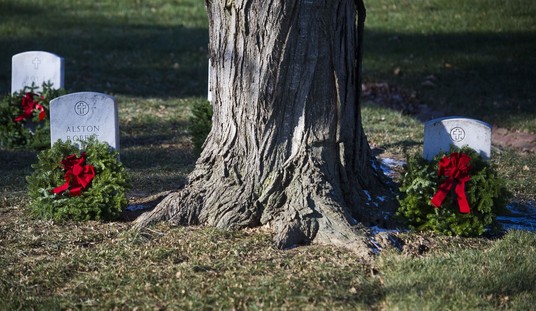The Top Five American Guns
While mulling over topics for this week’s Sunday Gun Day, I asked myself, “Myself, if I were to pick the five greatest American-designed and built firearms in history, what would I pick?”
So, here’s that list. It’s probably not surprising that the designs of John Browning figure prominently. Bear in mind that this is my list, presented for discussion, based on several criteria:
- Innovation in design.
- Commercial success.
- Longevity.
- Artfulness in design.
- How much I like them.
As always, your mileage may vary. So, without further ado:
The 1873 Colt Model P/Single Action Army/Frontier Six-Shooter
Introduced in 1873 and still in limited production today, not to mention widely copied, imitated, and cloned, the Colt Single Action Army is probably the best-recognized, most widely-known revolver in history. Not just American history, either.
 The old Colt is so ubiquitous in Western film that many an actual historical figure known to favor other models will be shown on screen with the Colt – and often firing a dozen or more shots from the gun’s six-shot cylinder. The gun, or at least a replica thereof, also features prominently in a certain actor's current legal troubles.
The old Colt is so ubiquitous in Western film that many an actual historical figure known to favor other models will be shown on screen with the Colt – and often firing a dozen or more shots from the gun’s six-shot cylinder. The gun, or at least a replica thereof, also features prominently in a certain actor's current legal troubles.
See Related: Alec Baldwin Enters Plea in 'Rust' Manslaughter Case
Movies aside, the Colt is not only one of the longest-lived sixguns in existence but also one of the most widely imitated. Originally a blend of features from two of the finest cap-and-ball sixguns – the 1851 Navy and the 1860 Army – the Colt was an immediate success and almost as quickly spawned copies and even improvements. The gun does have a few shortfalls, one of which is its sights. Urged on by users and gun writers, most vocal among them being one Elmer Keith, in 1961 Colt introduced the New Frontier model of the SAA, with good target-style adjustable sights. But a young whippersnapper named Bill Ruger had beaten them to the punch, in 1955 introducing the wonderful Blackhawk revolver – the basic Model P design with modern internals and good adjustable sights.
They say imitation is the sincerest form of flattery. If that’s true, then the old Colt sixgun has been flattered to a fare-thee-well.
The 1894 Winchester
Note: I would have to give the Marlin 336 an honorable mention here, but the fact is that the Winchester 94 was, almost from the day it hit the market, America’s Deer Rifle. While it has been sold in a variety of calibers, the .30WCF (.30-30) is so well known, so ubiquitous, so popular, so effective, that the 1894 Winchester and “30-30” have become damn near synonymous.
The ’94, designed by John Browning, was originally introduced in .32-40 and .38-55, both good rounds, but one wonders if the rifle would have achieved its impressive success were it not for the addition of the hot new .30WCF round in the second year of the rifle’s production. It’s a combination that regularly punches above its weight class. It’s used on tough feral hogs in Texas, and folks living in remote Alaska have killed a lot of moose with it.
As I pointed out in a recent Gold Standards piece, the pairing of the 1894 Winchester and the .30-30 was one of those rare, perfect matings of rifle and cartridge. I would not be a bit surprised to see these rifles still in use in the game fields in the 22nd century – assuming that any of the peasantry is still allowed to own any manner of arms by then.
The Colt/Browning 1911
Another of Maestro John Browning’s designs, the 1911 is probably the most influential martial sidearm in history. In use with the American military for over a century, the 1911 has spawned more copies and clones than any other semi-auto pistol. Its WW2 counterparts, including the famous German Luger, the less-famous P-38, the Japanese Nambus, and the British Webleys could not match the 1911 in reliability, ease of use, or (possibly excepting the Webley) hitting power, especially when combined with typical WW2-vintage ammo.
 After initial entry training, my first U.S. Army-issued weapon was a 1911A1 Colt. It’s not impossible that the sidearm I carried as a Company Aidman was the same one the Old Man carried as a bomber navigator in World War 2. It may not be graceful or pretty, but like a certain watch of note, the 1911 will take a licking and keep on ticking.
After initial entry training, my first U.S. Army-issued weapon was a 1911A1 Colt. It’s not impossible that the sidearm I carried as a Company Aidman was the same one the Old Man carried as a bomber navigator in World War 2. It may not be graceful or pretty, but like a certain watch of note, the 1911 will take a licking and keep on ticking.
Clones of the 1911 were manufactured all over the world, from Argentina to China to the Philippines. Nowadays, it would be easier to name all of the gun companies that don’t manufacture a 1911. Even Smith & Wesson, long the primary rival of original 1911 builder Colt, makes one. Like the Single Action Army, the 1911 is one of the most copied guns in history, and remains in military use around the world today, a hundred and ten years after its introduction.
The Model 1897 Winchester
And yet a third product of the inestimable genius of John Browning, this was the first pump-action shotgun successfully manufactured and sold in the United States. Every trombone-action scattergun on the market today owes a bit of its success to the mind of John Browning and the 1897 Winchester. While it wasn’t the first pump gun ever developed – that honor belongs to a slide-action gun designed in 1882 by Christopher Spencer, the designer of the lever-action Spencer rifle of Civil War fame – it was the first to achieve mass-market success.
What’s interesting is that the design first came out four years before as the Model 1893, which was only proofed for black-powder loads. This was a time when high-pressure smokeless rounds were hitting the market, and Winchester wanted a nitro-proofed pump gun. Browning replied with an improved version and thus was the Model 1897 born. In production until 1957, the gun sold over a million copies. One of those was John Browning’s personal shotgun, used regularly by the Maestro in the game fields until his death.
The ’97 was unfairly labeled “The Widowmaker” in some circles, because of a rumored fault where the bolt (not being in an enclosed receiver like later pump-guns) would fail and shoot backwards out of the action. I have never found an authenticated case of this happening. The ’97 is today what it was then, a unique piece, the first of its kind, and an American icon.
The Marlin Model 60
A plain, unremarkable little tube-mag-fed .22 semi-auto rifle, generally outfitted with open sights and a plain hardwood stock, this unassuming little .22 has the distinction of being the most widely used firearm in American history. Probably more Marlin 60s have been made and sold than any other single model of firearm, and they have been instrumental in having brought millions of kids and adults into the shooting sports.
It would be interesting to see, in one pile, all of the squirrels and rabbits that have been taken by kids with Marlin 60 rifles; I’d bet it would make an impressive pile. And the 60 is perfectly suited for such work. They aren’t overly sensitive to dirt, which is an important consideration where cheap promotional .22LR ammo tends to run dirty. And they’re more accurate than you’d expect a cheap, hardwood-stocked .22 rifle to be. When I was a little kid in Allamakee County, Iowa, in the days when boys and .22 rifles were generally found together all summer long, probably a third of my friends carried one version or another of the Marlin 60.
Marlin is now owned by Ruger, but a quick look at the Marlin website shows that the Model 60 is still in production – and is likely to stay that way. Over eleven million of these handy little plinkers have been made to date, and I wouldn’t be surprised if they make eleven million more – that is if gun-grabbers don’t get their way.
See Related: Delaware Passes Ridiculous Gun Control Law and Immediately Gets Sued
Honorable Mention: The AR-15
While I’m not a fan of Tacticool, I would be remiss in not at least mentioning the most popular rifle selling in the United States today. The AR has a lot going for it: good ergonomics, low recoil, and versatility. It’s a ridiculously easy piece to shoot well. It is the work of moments to swap uppers and go from a scoped target rifle to a short-barreled, short-range, fast-handling bullet launcher. New cartridge developments like the .450 Bushmaster can even convert it into a thumping brush gun suitable for deer and bears.
Full disclosure: I have an AR-15-pattern rifle myself, and so does my wife. Neither of us is huge Tacticool folk and we only shoot our ARs a couple of times a year – but the fastest way to get either of us to run out and buy a thing is to have finger-wagging slobs lecture us on why we shouldn’t be allowed to own one.
The AR is a useful rifle and, I have to admit, a practical one to own. I view my AR as I view my Glocks: Tools, like a hammer or a pipe wrench. I have them for a purpose, not for a hobby. My love I reserve for polished blued steel and fine walnut.
Conclusions
There is, of course, a lot of subjectivity in this sort of thing.
With that said, though, I actually did some thinking (a dangerous habit I picked up in my youth) about some criteria as to what could put a gun in the top five. As noted above, in my estimation it’s a combination of several things: Longevity, innovation, commercial success, and artfulness in design. All five of the guns I’ve named have those things in varying proportions.
Are they the only guns that could possibly be placed on such a list? No. I could easily come up with a Top One Hundred American Guns. The 1899 Savage lever gun would be in there somewhere, along with the pre-64 Model 70 Winchester, the 870 Remington sharing space with the Model 12 Winchester, the Smith & Wesson Triple Lock, and some lesser known but ahead of their time things like Charles Newton’s rifles.
But five was my goal and five I’ve provided. Comments?














